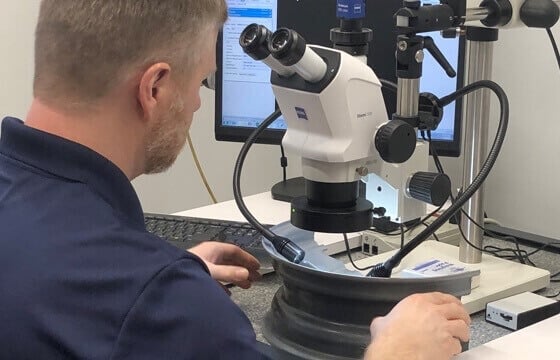
Dry Film Lubricant

YOUR PROCESS GOES SMOOTHER
When two surfaces slide against each other, they create friction, which can create a host of problems that disrupt your manufacturing. Dry film lubricant is an environmentally friendly, solid-state material applied to steel that helps reduce friction as it moves through your process.

End Uses
Smarter manufacturing for a wide range of applications.
Dry film lubricant helps improve steel formability and streamline the making of:
- Automotive frame components
- Mower decks
- Cylinders
- Tanks

A Simpler, Safer Option
Eliminates complications of working with liquid lubricants.
Using dry film lubricant instead of a liquid medium simplifies and streamlines your process. Worthington uses a borax-based dry film that helps you create a cleaner and safer work environment. And because it’s water soluble, you can remove it easily with a hot water rinse.

Save Wear And Tear
Stop the presses less and save on supplies.
Choosing dry film lubricant not only improves steel’s formability. It also increases the life of your tooling, decreasing time and interruptions to do die maintenance. It also means you won’t have to pay for drawing lubricants or chemical wash operations.

Full Capabilities
Check out our wide-ranging capabilities.
Collaborate with us to create the exact steel you need. We have the expertise, experience, and capacity to make your process even more efficient by adding:
- Pickling, skin pass temper rolling
- First operation blanking
- Slitting, oscillate slitting
- Cold rolling, one-pass rolling, temper rolling
- >Hydrogen annealing
- Cut-to-length sheets
- Galvanizing, galvalume, acrylic

Technical Solution
Cracking while drawing?
-
What are typical dry lube thicknesses? How do you measure coating weight?
Actual thicknesses average less than 100 microns. To measure coating weight—which varies from 100 to 1000 mg/sq ft—the most common method is titration with diluted HCL. This must be done on a flat surface.
-
Will dry lube carry through for me in progressive operations?
It depends on the part. In most cases sufficient dry lube will carry through progressive dies, but multiple draws or forming in the same location may require additional lube, as will in-die tapping and spin-forming operations.
-
Will dry lube “build up” on my tooling?
Yes, over time dry lubricant can accumulate on machine tools. Because it is water-soluble, you can readily wipe it away with a damp cloth—which should become part of your regular maintenance schedule.
-
Do I need to use die coatings with dry lubed steel?
Die coatings are not usually required for most tool steels. However, when using dry film, small pierce punches may have to be coated to protect against potential heat buildup.
-
Will dry lube vaporize? Come off in wet slurry tumbling?
Dry film lubricant vaporizes somewhat with heat and dissolves in water. Using TGA, we found that at 1800º F. there is a 45% weight reduction, mostly due to water loss. And yes, it will dissolve and be removed in a wet slurry tumbling operation.
-
What type of rust preventive is added to dry lube? Should I add one after drawing or forming?
It varies by supplier, but usually a 75% sodium nitrite solution is used to help prevent rust. If needed after processing, you can apply almost any rust preventive, based on your preference or our recommendation.
-
What is the shelf life if I store dry lubed steel?
Because it is water-based, the coating’s lubricity gradually decays, depending on your coil or blank storage practices. The expected shelf life is about three months in winter or in low humidity—shorter in more humid seasons or storage conditions.
-
Does dry lube dissipate heat as well as water- or oil-based lubricants I’ve used?
In most cases, it does not, but we believe the benefits of dry lube far outweigh any heat buildup. We’re ready to help you offset any issues should you experience higher tool and part temperatures.
-
Can I weld dry lube, and does it remain in the area after welding?
You can definitely weld dry lube, by adjusting cycle times and temperatures. Dry lube nearly eliminates smoking, reduces scale formation in the weld area, and produces minimal fuming. And it won’t remain in your weld area.
Helpful Resources
Worthington Cylinders used our dry film lubricant process to reduce costs by more than $1 milliion/year.










